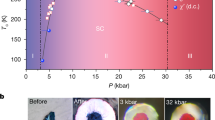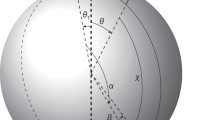Abstract
Many properties of the atomic nucleus, such as vibrations, rotations and incompressibility, can be interpreted as due to a two-component quantum liquid of protons and neutrons. Electron scattering measurements on stable nuclei demonstrate that their central densities are saturated, as for liquid drops. In exotic nuclei near the limits of mass and charge, with large imbalances in their proton and neutron numbers, the possibility of a depleted central density, or a ‘bubble’ structure, has been discussed in a recurrent manner since the 1970s. Here we report first experimental evidence that points to a depletion of the central density of protons in the short-lived nucleus 34Si. The proton-to-neutron density asymmetry in 34Si offers the possibility to place constraints on the density and isospin dependence of the spin–orbit force—on which nuclear models have disagreed for decades—and on its stabilizing effect towards limits of nuclear existence.
This is a preview of subscription content, access via your institution
Access options
Subscribe to this journal
Receive 12 print issues and online access
$209.00 per year
only $17.42 per issue
Buy this article
- Purchase on Springer Link
- Instant access to full article PDF
Prices may be subject to local taxes which are calculated during checkout



Similar content being viewed by others
References
Schultz, H. P. Topological organic chemistry. Polyhedranes and prismanes. J. Org. Chem. 30, 1361–1364 (1965).
Hoyle, F. On nuclear reactions occurring in very hot stars. I. The synthesis of elements from carbon to nickel. Astrophys. J. 1, 121–146 (1954).
Freer, M. & Fynbo, H. O. U. The Hoyle state in 12C. Prog. Part. Nucl. Phys. 78, 1–23 (2014).
Ebran, J.-P., Khan, E., Niks̆ić, T. & Vretenar, D. How atomic nuclei cluster. Nature 487, 341–344 (2012).
Mottelson, B. in Nuclear Structure, Trends in Nuclear Physics, 100 Years Later (eds Nifenecker, H., Blaizot, J.-P., Bertsch, G. F., Weise, W. & David, F.) 25–122 (Elsevier, 1998).
Hofstadter, R. Electron scattering and nuclear structure. Rev. Mod. Phys. 28, 214–253 (1956).
Campi, X. & Sprung, D. W. L. Possible bubble nuclei 36Ar and 200Hg. Phys. Lett. B 46, 291–295 (1973).
Davis, K. T. R., Krieger, S. J. & Wong, C. Y. Generalized shells in nuclei: Hartree-Fock calculations for bubble nuclei. Nucl. Phys. A 216, 250–270 (1973).
Khan, E., Grasso, M., Margueron, J. & Van Giai, N. Detecting bubbles in exotic nuclei. Nucl. Phys. A 800, 37–46 (2008).
Grasso, M. et al. Nuclear ‘bubble’ structure in 34Si. Phys. Rev. C 79, 034318 (2009).
Bender, M. et al. Shell structure of superheavy nuclei in self-consistent mean-field models. Phys. Rev. C 60, 034304 (1999).
Dechargé, J., Berger, J.-F., Girod, M. & Dietrich, K. Bubbles and semi-bubbles as a new kind of superheavy nuclei. Nucl. Phys. A 716, 55–86 (2003).
Cavedon, J. M. et al. Is the shell-model concept relevant for the nuclear interior? Phys. Rev. Lett. 49, 978–981 (1982).
Li, J. J., Long, W. H., Song, J. L. & Zhao, Q. Pseudospin-orbit splitting and its consequences for the central depression in nuclear density. Phys. Rev. C 93, 054312 (2016).
Wang, Y. Z., Hou, Z. Y., Zhang, Q. L., Tian, R. L. & Gu, J. Z. Pseudospin-orbit splitting and its consequences for the central depression in nuclear density. Phys. Rev. C 91, 017302 (2015).
Afanasjev, A. V. & Frauendorf, S. Central depression in nuclear density and its consequences for the shell structure of superheavy nuclei. Phys. Rev. C 71, 024308 (2005).
Yao, J.-M. et al. Beyond-mean-field study of the possible ‘bubble’ structure of 34Si. Phys. Rev. C 86, 014310 (2012).
Khan, S. et al. The mass of 35P and spin-parity assignments for excited 35P states. Phys. Lett. B 156, 155–158 (1985).
Mutschler, A. et al. Spectroscopy of 35P using the one-proton knockout reaction. Phys. Rev. C 93, 034333 (2016).
Paschalis, S. et al. The performance of the gamma-ray energy tracking In-beam nuclear array GRETINA. Nucl. Instr. Meth. A 709, 44–55 (2013).
Agostinelli, S. et al. Geant4: a simulation toolkit. Nucl. Instr. Methods A 506, 250–303 (2003).
Tripathi, V. et al. Intruder configurations in the A = 33 isobars: 33Mg and 33Al. Phys. Rev. Lett. 101, 142504 (2008).
Enders, J. et al. Single-neutron knockout from 34,35Si and 37S. Phys. Rev. C 65, 034318 (2002).
Burgunder, G. et al. Experimental study of the two-body spin-orbit force in nuclei. Phys. Rev. Lett. 112, 042502 (2014).
Ibbotson, R. W. et al. Quadrupole collectivity in 32,34,36,38Si and the N = 20 shell closure. Phys. Rev. Lett. 80, 2081–2084 (1998).
Rotaru, F. et al. Unveiling the intruder deformed 02+ state in 34Si. Phys. Rev. Lett. 109, 092503 (2012).
Ebran, J.-P. et al. Relativistic Hartree-Fock-Bogoliubov model for deformed nuclei. Phys. Rev. C 83, 064323 (2011).
Sorlin, O. & Porquet, M. G. Evolution of the N = 28 shell closure: a test bench for nuclear forces. Phys. Scr. 152, 014003 (2013).
Sorlin, O. & Porquet, M. G. Nuclear magic numbers: new features far from stability. Prog. Part. Nucl. Phys. 61, 602–673 (2008).
Sharma, M. M., Lalazissis, G. A., Hillebrandt, W. & Ring, P. Shell effects in nuclei near the neutron-drip line. Phys. Rev. Lett. 72, 1431–1434 (1994).
Sharma, M. M., Lalazissis König, G. & Ring, P. Isospin dependence of the spin-orbit force and effective nuclear potentials. Phys. Rev. Lett. 74, 3744–3747 (1995).
Lalazissis, G. A. et al. Reduction of the spin-orbit potential in light drip-line nuclei. Phys. Lett. B 418, 7–12 (1998).
Holt, J. W., Kaiser, N. & Weise, W. Nuclear energy density functional from chiral two-nucleon and three-nucleon interactions. Eur. Phys. J. A 47, 128–138 (2011).
Reinhard, P.-G. & Flocard, H. Nuclear effective forces and isotope shifts. Nucl. Phys. A 584, 467–488 (1995).
Todd-Rutel, B. G., Pieckarewicz, J. & Cottle, P. D. Spin-orbit splitting in low-j neutron orbits and proton densities in the nuclear interior. Phys. Rev. C 69, 021301 (2004).
Harakeh, M. N. et al. Direct evidence for a new giant resonance at 80A−1/3 MeV in the lead region. Phys. Rev. Lett. 38, 676–679 (1977).
Youngblood, D. H. et al. Isoscalar breathing-mode state in 144Sm and 208Pb. Phys. Rev. Lett. 39, 1188–1191 (1977).
Vandebrouck, M. et al. Measurement of the isoscalar monopole response in the neutron-rich nucleus 68Ni. Phys. Rev. Lett. 113, 032504 (2014).
Gade, A. et al. Reduction of spectroscopic strength: weakly-bound and strongly-bound single-particle states studied using one-nucleon knockout reactions. Phys. Rev. C 77, 044306 (2008).
Stroberg, S. R. et al. Single-particle structure of silicon isotopes approaching 42Si. Phys. Rev. C 90, 034301 (2014).
Tostevin, J. A. & Gade, A. Systematics of intermediate-energy single-nucleon removal cross sections. Phys. Rev. C 90, 057602 (2014).
Pandharipande, V. R. et al. Independent particle motion and correlations in fermion systems. Rev. Mod. Phys. 69, 981–992 (1997).
Barbieri, C. Role of long-range correlations in the quenching of spectroscopic factors. Phys. Rev. Lett. 103, 202502 (2009).
Dickhoff, W. H. & Barbieri, C. Self-consistent Green’s function method for nuclei and nuclear matter. Prog. Part. Nucl. Phys. 52, 377–496 (2004).
Duguet, Th., Hergert, H., Holt, J. D. & Somá, V. Nonobservable nature of the nuclear shell structure: meaning, illustrations, and consequences. Phys. Rev. C 92, 034313 (2015).
Furnstahl, R. J. & Hammer, H.-W. Are occupation numbers observable? Phys. Lett. B 531, 203–208 (2002).
Schiffer, J. P. et al. Test of sum rules in nucleon transfer reactions. Phys. Rev. Lett. 108, 022501 (2012).
Mutschler, A. Le Noyau-Bulle de 34Si: un Outil Experimental pour Étudier L’interaction Spin-Orbite PhD thesis, Univ. Paris XI (2015); https://tel.archives-ouvertes.fr/tel-01206188v1
Acknowledgements
This work is supported by the National Science Foundation (NSF) under Grant Nos. PHY-1102511 and PHY-1306297, the OTKA Contract No. K100835, and by the Institut Universitaire de France. GRETINA was funded by the US DOE—Office of Science. Operation of the array at NSCL is supported by the NSF under Cooperative Agreement PHY-1102511 (NSCL) and the DOE under grant DE-AC02-05CH11231 (LBNL). J.A.T. acknowledges support of the Science and Technology Facility Council (UK) grant ST/L005743.
Author information
Authors and Affiliations
Contributions
A.M. performed the offline data analysis, A.Lem., D.W. and K.W. performed on-line data analysis and checked the integrity of data taking. K.W. and A.Lem. performed GEANT4 simulations and wrote parts of the offline sorting code. A.G. and J.A.T. performed reaction theory calculations. D.B. operated the S800 spectrometer. D.W. and F.Re. were responsible for the setting up, calibration and operation of the Gretina array. H.I. and K.W. helped to set up the Gretina array. The manuscript was prepared by O.S., A.M., J.A.T., A.G., A.Lem. and E.K. J.-P.E. performed relativistic mean field calculations. Z.D. and D.S. contributed to the offline data analysis of the γ-ray spectra and C.B., R.B., E.K., A.Lem., A.Lep., H.I., T.R., F.Ro., M.S., M.V. and S.R.S. checked data accumulation on-line. O.S. proposed the experiment and supervised the analysis.
Corresponding author
Ethics declarations
Competing interests
The authors declare no competing financial interests.
Rights and permissions
About this article
Cite this article
Mutschler, A., Lemasson, A., Sorlin, O. et al. A proton density bubble in the doubly magic 34Si nucleus. Nature Phys 13, 152–156 (2017). https://doi.org/10.1038/nphys3916
Received:
Accepted:
Published:
Issue Date:
DOI: https://doi.org/10.1038/nphys3916
This article is cited by
-
Effect of quadrupole deformation & temperature on bubble structure in N = 14 nuclei
Hyperfine Interactions (2019)
-
β-decay study of neutron-rich nucleus 34Al
Science China Physics, Mechanics & Astronomy (2017)



